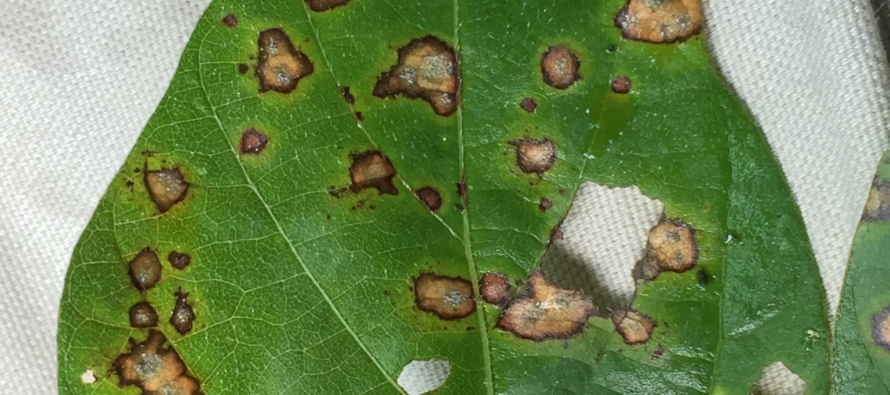The Principles of Plant Pathology: The Response of the Host

Related Articles
- Rice Variety Trial Results For 2010, Plus Rice Research Report 0
- Evaluation of Peanut Prescription Rx Program in Mississippi 0
- 2010 Row Crop Short Course Video Links 0
Latest Tweets

A susceptible (bottom) versus resistant (top) response of two different soybean varieties to frogeye leaf spot.
The host is one of the three legs of the disease triangle (see: https://www.mississippi-crops.com/2012/08/31/the-principles-of-plant-pathology-the-disease-triangle-and-influence-of-the-environment/ for information regarding the environment). In the MS crop production system, as well as many other crop production systems in the U.S., oftentimes the environment drives the occurrence of plant diseases. However, the specific host plant system (corn, cotton, grain sorghum, peanut, rice, soybean, wheat) can oftentimes dictate the specific disease present given the response of the host (variety or hybrid) planted in a given situation. The plant host plays an important role in the progression of disease as the response of the host can be broken described by several different, well defined responses. How we consider the role of the host all depends on the response of a particular variety (or hybrid in corn systems) to a given pathogen.
The terms used to define the different responses of the host are often used in trade publications, scientific journal articles, variety trial booklets, and in the information distributed by seed companies regarding the response of the commercial germplasm offerings to pathogenic organisms. How these defined responses relate to the production of disease on a particular host, or whether or not the host will respond by presenting disease, are important to clearly define. Terms and terminology are sometimes a confusing thing in agricultural production systems, but they can clearly aid in whether or not a particular management alternative should be employed to reduce the potential yield losses associated with plant diseases.
The specific responses of a given host plant can be broadly defined as:

A susceptible response to the stem canker pathogen as indicated by early plant death. Note the other varieties in the photo with differing responses to the stem canker fungus.
Susceptible: A susceptible variety would express substantial symptom expression associated with a given plant pathogen. Examples would include: severe leaf spotting associated with a disease such as frogeye leaf spot where the majority of the leaf surface would contain lesions or in the case of stem canker of soybean, the canker on the stem would extend up the majority of the stem. As another example, a susceptible response to stem canker could include premature defoliation and even early maturity or death of the variety in question.
Tolerant: The middle of the road when it comes to response to a plant pathogen. A classic definition of this particular plant response would be the ability of a plant to handle the effects of a plant pathogen without succumbing to serious injury or loss of yield. A plant with a tolerant response could be judged to produce symptoms as a result of infection, but not present a reduction in yield as a result. In general, a plant that is tolerant to disease also produces less reaction to the organism (or less lesions as an example) than the susceptible variety. However, lesion expression will be greater than as a result of a resistant variety. Many definitions of this particular term, tolerance, suggest that the usage of the word means to endure. In a broad sense, a variety (or hybrid) that tolerates a plant disease can infect, present symptoms associated with the disease, but produce as much yield as a resistant host. Rarely is the word “tolerant” used in variety trial booklets; however, when discussing information as it relates to plant pathology at times the word tolerant is used.
Resistant: In general, I think oftentimes the use of the word resistant is believed to mean immune. When a plant is resistant to a disease the disease can occur on that plant, but is dramatically reduced in appearance when compared to the susceptible response (see photo at top of the difference between frogeye leaf spot on a susceptible and resistant soybean variety). Ideally, a resistant variety greatly hinders the ability of a plant pathogen to develop in the presence of that particular host.
Immune: The immune response, and more importantly how to understand this particular response, would be a plant producing no symptoms at all even in the presence of a specific plant pathogen. In agricultural production systems, very few if any varieties (or hybrids) present what is truly considered as an immune response to a plant pathogen. I think oftentimes a resistant response is misinterpreted as being an immune response. As an example, if a field of continuous soybean were planted with a particular soybean variety and the environment was conducive for the development of disease and inoculum of a particular pathogen were present (let’s say the fungus responsible for frogeye leaf spot) then an immune response would result when the plant did not develop frogeye leaf spot lesions on any of the plant parts.
The difficult part to consider regarding the host responses listed above is that the environment continues to dictate the level of disease present on a given host, or variety/hybrid. In a year when the environment may only be marginally conducive for disease development then the expression of the host may not be observed to present near the level of disease that could be observed when the environment is ultra-conducive. For example, frogeye leaf spot of soybean during 2013 was expressed in many of the soybean varieties throughout the state due to the level of susceptible varieties present in the commercial offerings. In addition, the environment during that season was ultra-conducive to the development of the disease.




Let me tell You a sad story ! There are no comments yet, but You can be first one to comment this article.
Write a comment